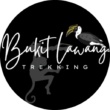Trekking Tips & Packing List
Read more about Trekking Tips and Packing List here.
- Clothes – bright, light, quick drying and breathable: The high temperatures and the oppressive humidity of tropical climates make you feel like walking around in swimming costumes. But the rainforest is home to poisonous plants and numerous insects. So it is advisable to wear light but long trousers in bright colours. Please consider wearing long socks to avoid bare skin between shoes and trousers. Once your clothes are wet, it is hard to dry them because of the constant humidity. That’s why a quick-drying T-shirt (light-weight fabric controlling perspiration) will be your best friend while trekking.
- Colours – Dark tones: dark colours are beneficial against sun and bugs. Dark clothes attract mosquitoes. The best colours to wear on a jungle trek are dark tones, like brown, beige and green, which don’t highlight you in the landscape and don’t scare the animals. Avoid strong colours like yellow, blue and red on your jungle trek!
- Shoes – comfortable with a rough profile: Light, comfortable hiking boots or sneakers are basically sufficient for hiking on flat and steep terrain. The massive amount of tropical rain often causes the ground to be muddy, so a rough- profiled sole is recommended. Sports shoes that dry quickly are advisable (additional sandals for crossing rivers – recommended only for Explorer & Observation treks). Our advice for safe jungle trekking is to choose shoes that are supportive and slightly above the ankle joint.
- Backpack – only for your personal belongings: You only need to prepare 1 small backpack (25-35 liters) for your personal belongings. All equipment (tent, mattress, sleeping bags, river tubes, safety jackets, helmets for children) as well as all food and drinking water while trekking will be provided by our team. You will have to carry your own small backpack, 1 water bottle and your sleeping bag while trekking. Your water bottle can be refilled any time at the campsite by our Bukit Lawang Trekking team.
- Protection – strong sun & insects: Insect bites are not only annoying but they are also a source of tropical diseases. Insect repellents are therefore an essential item for a pleasant jungle trekking experience. On top of that the sun is much stronger in the tropics than in moderate climates. Even when trekking through dense jungle with little exposure to direct sunlight there is the risk of sunburn. Sun lotion and a hat are necessary on each jungle trek. Additionally a cloth should cover the neck.
- Campsite – tips for the afternoon and night: We recommend light T-shirts and shorts in bright colours for the afternoon at the campsite and warm long trousers, long sleeved shirts & warm socks for the evening/night. Please always keep at least one set of dry clothes for the campsite! Additional travel tip for an overnight stay in the jungle: swimming suit, sunglasses, flipflop/sandals, raincoat, toilet paper, flashlight, quick-dry towel, personal belongings (environmentally-safe soap & shampoo, toothbrush & toothpaste, deodorant, hand sanitizer, feminine hygiene products, contact lenses . Electronic gear – double protection: You may have gathered by now that the rain forest is a pretty humid and wet environment, so if you are planning to bring any electronic gear (camera, lenses, mobile phone, USB power bank, charging cables, batteries, cards…) please make sure to protect it from the elements. All electronic gear should be kept in an extra plastic or waterproof bag. Also make sure your daypack has a rain cover and keep it on at all times during your jungle trek.
- Medication: Due to poor medical care we urgently advise not to travel to Sumatra without bringing your personal medical kit. Recommended medication for jungle treks includes e.g. anti-diarrhea medicine, dehydration salt, antihistamine, aspirin and antibiotics.
- Safety: In order to keep you as safe as possible in the jungle of Sumatra you have to abide by the rules and instructions given to you by the Bukit Lawang Trekking team at all times. By following these simple guidelines for the jungle, visitors are able to see the Sumatran orangutans at Bukit Lawang in a way which is both safe for themselves and for the orangutans.


